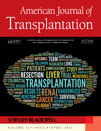Calculated PRA: A Process Whose Time Has Come or ‘Déjà vu’ All Over Again?
Abstract
The implementation of calculated PRA has been a success and is changing clinical practice; however, the concept is not new and there remains room for improvement. See article by Cecka et al on page 719.
Abbreviations:
-
- CPRA
-
- calculated PRA
-
- HLA
-
- human leukocyte antigen
-
- UNOS
-
- United Network for Organ Sharing
The use of calculated PRA (CPRA) based on center-defined unacceptable HLA antigens, was mandated by UNOS on October 1, 2009. CPRA was instituted in an effort to correct problems with the existing system including how PRA was defined and applied. In a previous issue of AJT, Cecka et al. (1) presented UNOS data detailing the positive impact of CPRA and virtual cross-matching during its first 6 months of implementation. The data presented show a significant decrease in the rate of declined kidney offers as a consequence of a positive cross-match yet report an increase in the percentage of highly sensitized patients receiving a compatible transplant. While these data are truly significant, a few additional points need mentioning: (1) historical studies leading to CPRA implementation; (2) CPRA versus virtual cross-match; (3) current limitations to CPRA and (4) impact of CPRA on clinical outcomes.
Although the implementation of CPRA is recent, the concept of detailed HLA antibody analysis resulting in a greater percentage of highly sensitized patients receiving a transplant is not new. In 1983 Delmonico et al. (2) showed that detailed antibody analysis based on public epitopes, as defined by Fuller and Rodey (2), could successfully predict compatible donor:recipient pairs. The application of this approach to predict compatibility resulted in a significant increase in the percentage of highly sensitized patients transplanted (14–29%). Subsequently, using similar methods, Oldfather et al. (3) showed comparable compatibility predictions for donor:recipient selection. In fact, as was written in the abstract:
This approach to donor selection reduces unnecessary cross-matching and increases the likelihood of finding cross-match-compatible donors for highly reactive patients.
What then, is the driving force that has allowed such a remarkable nationwide experience some 25 years after the recognition of the importance of detailed HLA antibody analysis?
To address this we must first note that when CPRA was initially proposed it was not intended to be used as a virtual cross-match; however, that is the current utilization via this mandate. It is also important to recognize that CPRA and virtual cross-matching are just different sides of the same coin. For transplant programs wishing to minimize the risk of antibody mediated rejection, listing appropriate unacceptable antigens to predict a negative cross-match is desirable. Such practices have been in place at many institutions for a number of years. In the United States assigning unacceptable antigens to avoid a positive cross-match is referred to as virtual cross-matching (4) and in Europe, the Acceptable Mismatch Program (5). Both approaches have been successful in identifying compatible organs for highly sensitized patients. It is encouraging to see that, when mandated at a national level, the practices voluntarily embraced by a few are now being accepted by all and attaining beneficial clinical results. Thus, while the concept of CPRA has contributed to this success, we believe that the mandated listing of unacceptable antigens has been the primary driving force. It is equally important to note that confidence in HLA antibody assignments would not have been possible without the advances in solid-phase HLA antibody testing that have taken place over the past 10+ years (6).
Although still evolving, mandating unacceptable antigens and CPRA has been a success. However, other HLA loci (e.g. DP and DQA), whose specificities are prominent among highly sensitized patients are not yet considered in CPRA or as unacceptable antigens. We recognize the challenges with these loci for CPRA calculations but allowing their inclusion as unacceptable antigens, similar to C-locus, would be appropriate. Of course, in order for this to be applicable to the virtual cross-match, UNOS must mandate molecular HLA typing and reporting of all HLA loci for donors and recipients. Additionally, high-resolution antibody analysis has identified many allele-specific antibodies the presence of which, limits the ability to predict compatibility for some of the most difficult patients. This is particularly troublesome when a patient possesses an allele-specific antibody within the same antigen group as his/her own HLA type (e.g. patient is B*4402 but has antibodies against B*4403). Currently, allele level assignments cannot be entered into UNET for either donor/patient typings or recipient antibodies. As UNOS moves forward, it will be important to: (1) include in the calculation for CPRA, all HLA specificities that a transplant center deems unacceptable; (2) bring HLA typing to a level of resolution compatible with routine HLA-antibody detection and (3) determine the impact of CPRA on clinical outcomes (i.e. allograft rejection rates, allograft survival) on a national level.
The success of CPRA and mandated unacceptable antigen listing has been an important accomplishment. This success was built on a concept that has been recognized for many years and preceded by the efforts of numerous individuals whose wisdom, foresight and innovation made such a current achievement possible. Hopefully, we can utilize the information gained from both past and present endeavors to expedite our future advances.
Disclosure
The authors of this manuscript have no conflicts of interest to disclose as described by the American Journal of Transplantation.




